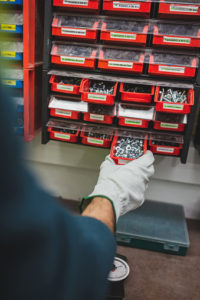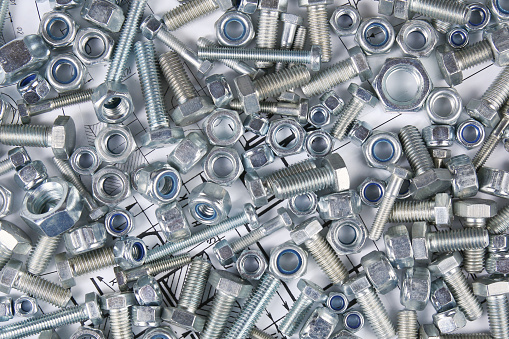Industrial Fasteners are a large range of metals, wood pieces, and other materials that help strengthen the structure’s load-bearing parts. They are sometimes referred to as fastening hardware or construction fastening devices. Industrial Fasteners modern designs have come about to provide easy installation, exact configurations for each project, greater safety and life span than conventional types.
Types of Industrial Fasteners
Industrial fasteners are devices used to hold two objects together. The device can be a bracket, bolt, rivet, or blind clamping screw. Industrial fasteners usually have a deep thread and they come in varied forms such as rod threaded with bar, clinched end-cap socket head cap screws, rolled end-cap upturned tee nuts, and spring pin nuts. Industrial fasteners are diverse and affect performance in different ways. For example, tapping screws grip better on thin-walled steel tubes, but may wear out quickly on thick steel bars. Thrust plates are the best option for applications needing continuous sheer horsepower, while hinged grippers are used where hinged fingers might not be strong enough.
There are four basic types of industrial fasteners. They are more commonly known as anchors, bolts, nuts, and washers. Some fasteners include additional parts which help with their performance or protection on the installed item. Some other types of fasteners are rivets, screws, nails, sheet metal screws, or expansion bolts. Each type has its pros and limitations depending on what the fastener is meant for. Most common are nuts and bolts which are used to join two objects by engaging threads. In industry, there are a variety of industrial fasteners that hold parts together in joins, perform motion functions, add support to the part, and attach power tools.
The Function of Industrial Fasteners:
 Industrial fasteners come in various types and they differ in their names and shapes, but each type serves a specific purpose. Bolts, screws, rivets, and springs are often used to connect two objects such as two pieces of metal attaching. For machines, the fasteners operate within a range while for other cases like construction they should be easily attachable and removable while still having enough power to hold. Most Industrial Fasteners fall into one of three classifications: threaded, nuts and bolts, and fasteners made of wire. The type of Industrial Fastener will depend on your application and the load it is under, while their function stays essentially the same: they need to make something strong and reliable. Industrial fasteners are made out of a variety of materials such as steel, Aluminum, plastic, and others.
Industrial fasteners come in various types and they differ in their names and shapes, but each type serves a specific purpose. Bolts, screws, rivets, and springs are often used to connect two objects such as two pieces of metal attaching. For machines, the fasteners operate within a range while for other cases like construction they should be easily attachable and removable while still having enough power to hold. Most Industrial Fasteners fall into one of three classifications: threaded, nuts and bolts, and fasteners made of wire. The type of Industrial Fastener will depend on your application and the load it is under, while their function stays essentially the same: they need to make something strong and reliable. Industrial fasteners are made out of a variety of materials such as steel, Aluminum, plastic, and others.
Depending on the need and project, these various materials can be combined to achieve the desired function. Industrial fastener types include rivets, pins, screws, and washers. Rivets come in disc-head and blind-head varieties. Disc-head rivets create multiple holes on the item being attached whereas blind-head rivets typically attach one thing to another with a flat head surface that fits into a circular hole on the second object.
Industrial bolts and nuts can be classed into a few types–depending on their point span, set back, thread type, slipperiness, shaft diameter, hardness, impact energy absorption, service temperature range, etc. Industrial bolts have threaded shanks or threaded bodies with parallel flats for ease of construction and breaking. Industrial fasteners are mandatory for building a new structure. Their mountings, fastener types, and functions distinguish each entity of wall systems from one another.
How Do They Work?
Industrial fastening can be divided into two types – mechanical and adhesive. Adhesives are applied to the surface of the parts that need to be connected, whereas mechanical connections are created by press-fitting components together. Industrial fasteners are physical items used for joining or securing, using friction and gravity. The intent is that the physical connection between flanges, shafts, and housings remains intact and that all of these fragments move together without unjoining.
If you’re wondering, “what does ‘industrial flange’ mean?”, all it means is a hollow cylinder with a longitudinal kerf and distal head formed by inset, lateral face cuts which extend the flange length to provide increased strength. Industrial fasteners are designed to work in specific locations, each with its own function for removing or tightening an object.
Fasteners are joining fixtures together with enormous efficiency. Industrial fasteners were first designed to hold assemblies in place, create frictionless surfaces, or improve the safety of machine tools. Fasteners use compression, tension, or shear forces which can be very versatile. Industrial fasteners are found on millions of machines every day and many types of mechanical constructions influence their design.
Conclusion
Industrial fasteners work by providing a surface for things to attach to. They come in different alloy types and shapes depending on what you need them to do. When determining what kind of Industrial Fastener(s) is appropriate for your jobs, such as the type of metal and shape, make sure you choose the type of fastener that works with the details of your project. Industrial Fasteners work well in a wide variety of applications and industries.


Recent Comments